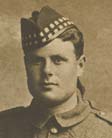In Memory of
William MILNE
Corporal
265117
'H' Coy.,1st/6th Bn., Gordon Highlanders
who died on
Monday, 9th April 1917. Age 21.
|
Additional Information: Click on images to view details
|
Son of George and Jane Milne George Milne, d Mill o' Noth, Rhynie 22/4/1955
age 95, Jane Harvey d there 6/7/1948 age 84. His father farmed at Halls, Duncanstone and later at Bogend, Clatt. 1914 Star, War & Victory Medals, France 10/11/1914, previously 960 SDGW - Wm Milne,
Cpl, 6GH, b Leslie, e Insch, Killed in Action, F & F. This is the
only one found in records (3 in GH) As a member of "H" Company 6GH (Territorial Force) Pte William Milne reported to Company HQ at Huntly following the order to mobilise on 4th August 1914 and proceeded to France with the battalion (BEF) on 9th November. This qualified him for the 1914 or Mons Star in addition to the British War and Victory Medals. ( Book, 6 GH in F & F) Wm Milne, b Leslie, in "H" Coy, res
Clatt. Info book, 6 GH in F & F CWGC records, previously buried at map ref : A30 A 05.05 9/4/1917, Start of Battles of Arras, 6 GH involved in initial assault. 9/4/1917 Battles of Arras and Vimy, The only
action when 9th, 15th and 51st Divisions attacked together. Captured
all objectives and pushed forward two miles. Secured the flank of Vimy
Ridge. 6 GH War Diary entries, April 1917 On the 9th the BATTLE of ARRAS opened. The objective
given the Battalion was the front line system of trenches, viz;- Firing
Line, Support Line, and Reserve Line, known as the " Black"
Line. 1/4/1908 The original Volunteer Battalions was
reorganised and the 4th became the 6th Batt ( Territorial Force) comprising
8 companies centred in the following areas; During 1914 the 8 Company system of the entire
British army was changed to 4, usually 'A', 'B', 'C' and 'D'
Service notes 4/8/1914 at Keith: Gordon Brigade, Highland Division.
|
Commemorative Information
| Cemetery: | ROCLINCOURT VALLEY CEMETERY, Pas de Calais, France |
| Grave
Reference/ Panel Number: |
II. F. 3. |
|
Location:
|
Roclincourt is a village a little to the east
of the road from Arras to Lens. Take the N17 from Arras until the junction
of this road and the D60. Travel along the D60 into Roclincourt village.
Roclincourt Valley Cemetery lies to the north-east of the village and
to the east of the road to Thelus. |
| Historical Information: | Roclincourt was just within the British lines before the Battles of Arras, 1917; and it was from the village that the 51st (Highland) and 34th Divisions advanced on the 9th April, 1917. The 1st Canadian Division attacked further North, across the Lens road. Roclincourt Valley Cemetery (originally called Roclincourt Forward Cemetery No. 2) was begun after the 9th April, 1917, by the units which fought on that day, and used until the following August; and it then contained the graves of 94 soldiers, of whom 40 belonged to the 51st Division and five were French soldiers who had fallen in 1915. (The French graves have been removed.). Plot I, Row F, was completed, and Plots II-IV made, after the Armistice, by the concentration of graves from smaller cemeteries and from the battlefields. These graves are almost all of April, 1917, and the majority of the soldiers buried in them belonged to the 34th and 51st Divisions. Three of the wooden memorial crosses of the Tyneside battalions were brought in at the same time. There are now nearly 550, 1914-18 war casualties commemorated in this site. Of these, over 80 are unidentified and special memorials are erected to four soldiers from the United Kingdom known, or believed, to be buried among them. The cemetery covers an area of 2,110 square metres and is enclosed by a stepped rubble wall. The more important cemeteries concentrated into Roclincourt Valley Cemetery were the following:-. KING CRATER CEMETERY, ROCLINCOURT, 1.6 kilometres East of the village, in a mine crater far from any road. It contained five big graves, made by the 34th Division in the middle of April, 1917; and in them were buried 99 soldiers from the United Kingdom, all of whom fell on the 9th April, and all but two of whom belonged to the Tyneside Brigades of the Northumberland Fusiliers. KITE CRATER CEMETERY, ST LAURENT-BLANGY, 1.6 kilometres South-East of Roclincourt village. It contained five big graves, in which were buried 53 soldiers from the United Kingdom (mainly of the 34th Division), who fell on the 9th April, 1917. RABS ROAD CEMETERY, ST LAURENT-BLANGY, on the Arras Bailleul road, 1.6 kilometres South-East of Roclincourt village. It contained the graves of 20 soldiers from the United Kingdom, 16 of whom belonged to the 15th or 16th Royal Scots, and all of whom fell on the 9th or the 13th April, 1917. ROCLINCOURT LONG CEMETERY (called at one time Roclincourt Forward Cemetery No. 3), in a field 1.2 kilometres North of the Village. It contained the graves of 68 officers and men of the 51st Division who fell on the 9th April, 1917. THELUS ROAD CEMETERY, ROCLINCOURT, by the roadside 1.6 kilometres North of the village. It was made by the XVII Corps, and it contained the graves of 42 officers and men of the 51st Division who fell on the 9th April, 1917. |


